 NGC7332,NGC7339 ,
NGC7479 (Updated Sep. 28, 2025)
NGC7332,NGC7339 ,
NGC7479 (Updated Sep. 28, 2025)
 NGC7332,NGC7339 ,
NGC7479 (Updated Sep. 28, 2025)
NGC7332,NGC7339 ,
NGC7479 (Updated Sep. 28, 2025)
M31
|
NGC3628
|
NGC4567,4568
|
|
Designation: M31 Alternate Name: Andromeda Galaxy Constellation: Andromeda Imaging Date: November 23, 2023 Imaging Location: Concord Exposure Time: 94 frames@180sec ~ 4.7hrs Gain Setting: 100 Imaging Device: ZWO ASI2600 Optics: Classic LX200 12" SCT Focal Reducer: Meade Series 4000 f/6.3 Filter: Optolong L-eNhance Apparent Size: 20' x 18' region Comment: My first attempt at combining hydrodgen alpha images with RGB! Andromeda has always been my favorite galaxy. A galaxy twin with another Terry looking back at me. I combined about 1.5h of RGB with 3h of HA using an L-enhance filter on my ASI2600mc camera. All images were 3 min unguided exposures over several nights in mid November (2023) using my Paramount MyT mount and 12inch Meade LX200 w focal reducer. I've convinced myself combining HA with RGB really is more of an art than a science, especially when trying to use the HA from an L-enhance filtered image. The main idea is to try to isolate (as well as possible) the HA signal in the red channel of the L-enhance image. You'll see all sorts of heuristic formalae on the net to do that, but the general goal is to find a way to somehow A. subtract the stars and B. to subtract what might be non-HA red signal. (A) can be accomplished by subtracting the stars from the red channel L-enhance image using e.g. StarNet++ or something analogous. (B) can be accomplished by (roughly) subtracting the RGB red channel from the red channel L-enhance image. The latter is a little more complicated than that, but that's the general idea. Finally, adding the HA to the RGB is done through pixel math, weighting the isolated HA signal in anyway that pleases you. After all, what matters the most is how the image looks to you. You can click here to see my relatively unprocessed L-enhance image and HA regions more clearly. I sacrificed some of the HA detail to get a "prettier" final image, but I liked the warmer color and almost liquid-like texture of the core. The HA image just seemed so cold and sterile to me, like the hydrogen emitting it |
Designation: NGC3628 Alternate Name: Sarahs Galaxy Constellation: Leo Imaging Date: May 10, 2023 Imaging Location: Concord Exposure Time: 68 frames@300sec ~ 5.7hrs Gain Setting: 200 Imaging Device: ZWO ASI2600 Optics: Classic LX200 12" SCT Focal Reducer: Meade Series 4000 f/6.3 Filter: none Apparent Size: 15' x 3.6' Comment: This is an unbarred spiral galaxy about 35 million light years away, part of the Leo triplet. The fuzzy blob in the center just above it is a satellite galaxy. Of note is that the FOV associated with it is ideal for Pixinsight processing with stars removed and then added back in. There isn't a very large variance in star size, enabling StarNet++ to successfully extract them all, leaving minimal artifacts.I don't often use that method, but it worked well in this case. Otherwise I used my typical workflow: DBE, PCC, BXT, EzDenoise, EzSoftStretch, remove stars, enhance, then return them and do minor touch ups. Here's my previous 28min exposure oh some many years ago with my 10inch and T3i DSLR. |
Designation: NGC4567,4568 Alternate Name: Siamese Twins Galaxies Constellation: Virgo Imaging Date: May 31, 2014 Imaging Location: Concord Exposure Time: 80 frames@20sec ~ 26.7min Gain Setting: ISO 1600 Imaging Device: Canon Rebel T3i Optics: LX200R 10" SCT Focal Reducer: Optec Lepus 0.62X Filter: none Apparent Size: 2.9' x 2.0' / 4.6' x 2.0' Comment: A beautiful pair of near interacting galaxies in an early phase of collision! Also known as "The Butterfly Galaxies", the pair is roughly 120 million light years away shown here in the same field of view as NGC4564 (top right) and a 14.4 mag galaxiy named IC3578 (lower left). |
WBL130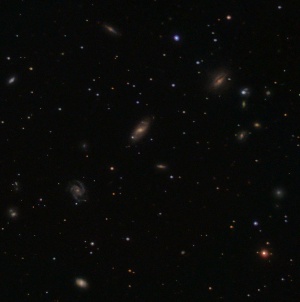
|
NGC6175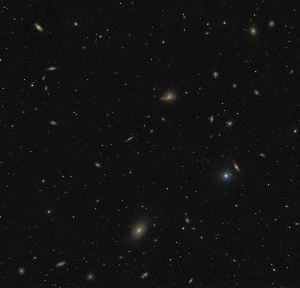
|
NGC4216
|
|
Designation: WBL130 Alternate Name: UGC03679,PGC20178,UGC03673 Constellation: Lynx Imaging Date: November 25, 2022 Imaging Location: Concord Exposure Time: 179 frames@180sec ~ 8.9hrs Gain Setting: 100 Imaging Device: ZWO ASI2600 Optics: Classic LX200 12" SCT Focal Reducer: Meade Series 4000 f/6.3 Filter: none Apparent Size: FOV: 10' x 10' Comment: This is a small cluster of galaxies called WBL 130 in the WBL catalog, referred to as the Catalog of Nearby Poor Clusters of Galaxies of White et al. (1999). White's group identified about 732 nearby "poor clusters" of galaxies consisting of three or more galaxies with photographic magnitudes brighter than 15.7. The magnitude cutoff implicitly limits their redshift and distance. Why have yet another catalog for this class of galaxy clusters? They are thought to be important as building blocks of clusters and superclusters, and relevant to understanding the formation and evolution of large-scale structure in the universe. The larger members here are thought to be about 300 million light years away based on their redshift. However there are a large number of other galaxies much further away in this beautiful field of view. |
Designation: NGC6175 Alternate Name: Abell 2197 Constellation: Hercules Imaging Date: July 3, 2022 Imaging Location: Concord Exposure Time: 138 frames@180sec ~ 6.9hrs Gain Setting: 100 Imaging Device: ZWO ASI2600 Optics: Classic LX200 12" SCT Focal Reducer: Meade Series 4000 f/6.3 Filter: none Apparent Size: FOV: 24' x 24' Comment: My own little Hubble deep field ... a beautiful collection of galaxies strewn throughout a patch in Hercules. I'm having a lot of fun trying longer and longer exposures of parts of the sky allowing me to get images like this. The BlurXTerminator algorithm available in Pixinsight is particularly useful for galaxy fields like this. It does an outstanding job of deconvolution, yet leaves galaxy structures intact, enabling them to stand out nicely from the background stars. |
Designation: NGC4216 Alternate Name: Cannibal Galaxy Constellation: Virgo Imaging Date: June 4, 2022 Imaging Location: Concord Exposure Time: 56 frames@180sec ~ 2.8hrs Gain Setting: 100 Imaging Device: ZWO ASI2600 Optics: Classic LX200 12" SCT Focal Reducer: Meade Series 4000 f/6.3 Filter: none Apparent Size: 8.1' x 1.8' Comment: I finally revisited this beautiful trio of galaxies with my 12 inch. Of course, with my 10 inch, I only hinted at the other two companions! Here's my previous version. Fascinating edge-on galaxy roughly 55 million light years away, near the center of the Virgo cluster. It has almost five times the number of globular clusters in our galaxy and has stellar streams connected to two satellite galaxies it appears to be disrupting. There are multiple galaxies visible in this image including most prominently NGC4222 below. There seems to be a great deal of galactic activity in the Virgo cluster, and this galaxy is near the center of it all! Here's a more recent version of it with the recent supernova ! |
NGC7331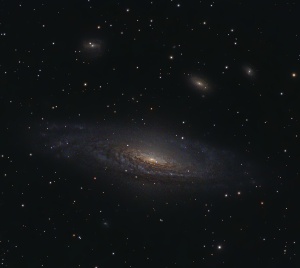
|
M87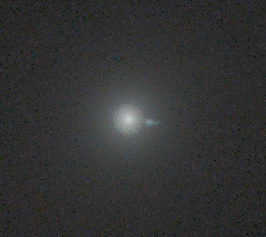
|
NGC4676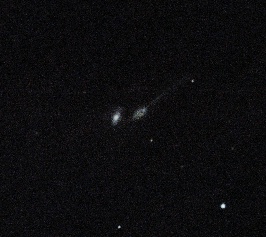
|
|
Designation: NGC7331 Alternate Name: Caldwell 30 Constellation: Pegasus Imaging Date: July 25, 2025 Imaging Location: Concord Exposure Time: 55 frames@180sec ~ 2.8hrs Gain Setting: 100 Imaging Device: ZWO ASI2600 Optics: Classic LX200 12" SCT Focal Reducer: Meade Series 4000 f/6.3 Filter: none Apparent Size: 10.5' x 3.7' Comment: Supernova in NGC7331 discovered July 14, 2025, only two weeks before I took this image! The galaxy is located about 40 million light years away in the constellation Pegasus. You can see the tiny bright supernova explosion right beside the core of the galaxy. I thought it was supposed to be white, but after processing in Pixinsight (which does a spectral analysis of the stars to determine appropriate colors) PI made it blue, which is actually its correct color! Take a look here to see what it normally looks like without the supernova:) |
Designation: M87 Alternate Name: Relativistic Jet Constellation: Virgo Imaging Date: April 17, 2013 Imaging Location: Concord Exposure Time: 40 frames@20sec ~ 13.3min Gain Setting: ISO 3200 Imaging Device: Canon Rebel T3i Optics: LX200R 10" SCT Focal Reducer: Optec Lepus 0.62X Filter: none Apparent Size: 8.3' x 6.6' Comment: |
Designation: NGC4676 Alternate Name: The Mice Galaxies Constellation: Coma Berenices Imaging Date: May 4, 2013 Imaging Location: Concord Exposure Time: 75 frames@20sec ~ 25.0min Gain Setting: ISO 6400 Imaging Device: Canon Rebel T3i Optics: LX200R 10" SCT Focal Reducer: Optec Lepus 0.62X Filter: none Apparent Size: 2.3' x 0.7' / 2.2' x 0.8' Comment: |
Arp65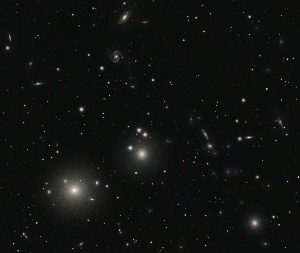
|
Stephans-Quintet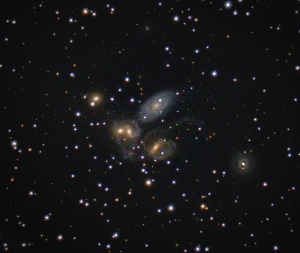
|
NGC4214
|
|
Designation: Arp65 Alternate Name: NGC79 96 Constellation: Andromeda Imaging Date: December 13, 2023 Imaging Location: Concord Exposure Time: 189 frames@180sec ~ 9.4hrs Gain Setting: 100 Imaging Device: ZWO ASI2600 Optics: Classic LX200 12" SCT Focal Reducer: Meade Series 4000 f/6.3 Filter: none Apparent Size: 20' x 25' region Comment: A beautiful collection of galaxies in Andromeda! This is a 9.5h exposure I took this year in mid December 2023. I've provided an annotated image here to showcase the myriad galaxies in this small field of view. There's at least another dozen unannotated little fuzzies scattered throughout the field. Interestingly, there are quite a few NGC objects that are just stars: NGC82 and NGC91 to name two in this FOV. The designation Arp 65 applies to the pair of interacting galaxies in the upper middle region, comprising NGC 90 and NGC 93. For whatever reason, Pixinsight applied the catalogue label PGC1405 instead of NGC90. |
Designation: Stephans-Quintet Alternate Name: NGC7317 NGC7320 Constellation: Pegasus Imaging Date: November 5, 2021 Imaging Location: Concord Exposure Time: 72 frames@180sec ~ 3.6hrs Gain Setting: 200 Imaging Device: ZWO ASI2600 Optics: Classic LX200 12" SCT Focal Reducer: Meade Series 4000 f/6.3 Filter: none Apparent Size: 1.1'x 1.1' / 0.9'x 0.9' / 1.9'x 1.2' / 1.7'x 1.3' / 2.2'x 1.1' Comment: Finally some nice detail with my 12" and cooled camera! Here's my earlier attempt with my 10" and much shorter exposure about 8 years ago here. |
Designation: NGC4214 Alternate Name: Dwarf Galaxy Constellation: CanesVenatici Imaging Date: May 1, 2022 Imaging Location: Concord Exposure Time: 178 frames@180sec ~ 8.9hrs Gain Setting: 200 Imaging Device: ZWO ASI2600 Optics: Classic LX200 12" SCT Focal Reducer: Meade Series 4000 f/6.3 Filter: none Apparent Size: 8.4' x 6.6' Comment: NGC4214 in Canes Venatici is a barred irregular galaxy larger and more luminescent than the Small Magellanic Cloud but about 10 million light years away. Its companion galaxy UGCA 276 is faintly visible in the top left part of the image. |
M102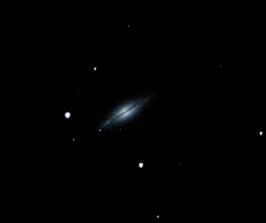
|
NGC2683
|
NGC672,IC1727
|
|
Designation: M102 Alternate Name: NGC5866 Constellation: Draco Imaging Date: May 7, 2013 Imaging Location: Concord Exposure Time: 75 frames@20sec ~ 25.0min Gain Setting: ISO 3200 Imaging Device: Canon Rebel T3i Optics: LX200R 10" SCT Focal Reducer: Optec Lepus 0.62X Filter: none Apparent Size: 4.7'x 1.9' Comment: |
Designation: NGC2683 Alternate Name: UFO Galaxy Constellation: Lynx Imaging Date: March 6, 2021 Imaging Location: Concord Exposure Time: 95 frames@180sec ~ 4.8hrs Gain Setting: 100 Imaging Device: ZWO ASI2600 Optics: Classic LX200 12" SCT Focal Reducer: Meade Series 4000 f/6.3 Filter: none Apparent Size: 9.3' x 2.2' Comment: About 20 million light years away, this magnitude 10.6 barred spiral galaxy has beautiful reddish dust lanes and several regions that show up in Halpha, regions I could not have gotten previously with my DSLR. This galaxy apparently has more than twice the number of globular clusters in our galaxy. The key to imaging in this case seems to be not so much longer exposure as it is good focus, good tracking and steady atmosphere, all of which could probably stand for some improvement. Here's my previous attempt with my 10 inch under fairly good conditions. Interestingly, on trying to reconcile the apparently different detail I was seeing in my two attempts, I realized my 10inch attempt actually only images the central part of the galaxy, while the newer attempt extends the edges of the galaxy about twice the distance out! |
Designation: NGC672,IC1727 Alternate Name: Interacting Pair of Galaxies Constellation: Triangulum Imaging Date: December 10, 2020 Imaging Location: Concord Exposure Time: 101 frames@180sec ~ 5.1hrs Gain Setting: 0 Imaging Device: ZWO ASI2600 Optics: Classic LX200 12" SCT Focal Reducer: Meade Series 4000 f/6.3 Filter: none Apparent Size: 6.2' x 2.3' / 6.5' x 2.4' Comment: NGC672 is a spiral galaxy interacting with a dwarf galaxy called IC1727. The pair is located about 23 million light years away and is thought to be part of a cluster of dwarf galaxies formed along a filament of intergalactic gas accreted on a dark matter "backbone". Methods to detect that intergalactic gas are currently underway. The sensitivity of the ASI2600mc camera is notable in this 5 hour exposure, revealing nice structure in the larger pair of galaxies but also bringing out multiple edge on galaxies in the field as well, in addition to several "fuzzies" around NGC672 itself. There's no way I could have gotten this much detail using my DSLR! |
NGC891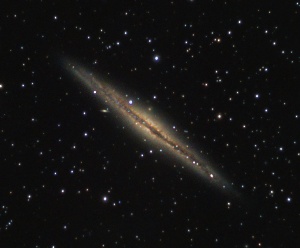
|
NGC3077
|
M95
|
|
Designation: NGC891 Alternate Name: Dark Star Galaxy Constellation: Andromeda Imaging Date: September 19, 2020 Imaging Location: Concord Exposure Time: 154 frames@120sec ~ 5.1hrs Gain Setting: ISO 1600 Imaging Device: Canon Rebel T3i Optics: Classic LX200 12" SCT Focal Reducer: Meade Series 4000 f/6.3 Filter: none Apparent Size: 12.0' x 1.0' Comment: NGC891 is a beautiful example of an edge-on galaxy, about 30 million light years away in Andromeda. Apparently this galaxy is very similar to what our galaxy would look like seen edge-on. You can see glimpses of that yourself on very dark summer nights looking into the center of the Milky Way! Its many filaments and tendrils extending out of its plane are thought to be the result of the ejection of material due to supernovae and intense stellar formation activity. In the upper left part of the image, right under NGC891, you can also see a tiny image of a distant spiral galaxy in the background. Upping the aperture and exposure time really does bring out some nice detail! Here are my previous attempts at 20 minutes and 52 minutes exposure time, both with my 10 inch. |
Designation: NGC3077 Alternate Name: Dwarf Galaxy Constellation: UrsaMajor Imaging Date: April 22, 2022 Imaging Location: Concord Exposure Time: 118 frames@180sec ~ 5.9hrs Gain Setting: 200 Imaging Device: ZWO ASI2600 Optics: Classic LX200 12" SCT Focal Reducer: Meade Series 4000 f/6.3 Filter: none Apparent Size: 5.4' x 4.5' Comment: NGC3077 is also a starburst dwarf galaxy just a little further at 12 million light years. Its disrupted structure suggests some sort of galaxy interaction in its past. Its young star bluish core has a small inner disk of older stars visible as a small reddish peanut shaped object in the galaxy's center. What a stunninglittle galaxy! |
Designation: M95 Alternate Name: Barred Spiral Galaxy Constellation: Leo Imaging Date: April 20, 2022 Imaging Location: Concord Exposure Time: 170 frames@180sec ~ 8.5hrs Gain Setting: 200 Imaging Device: ZWO ASI2600 Optics: Classic LX200 12" SCT Focal Reducer: Meade Series 4000 f/6.3 Filter: none Apparent Size: 3.1' x 2.9' Comment: Home of the Green Lantern? Difficult barred spiral, but nice ring like structure. Even with more than 8h of exposure, it could still use more to get the arms to come out with more contrast. My first attempt with my 10 inchoh so many years ago did not do it justice. |
M81
|
NGC7640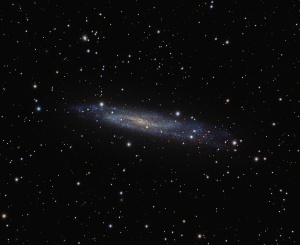
|
NGC6503
|
|
Designation: M81 Alternate Name: Bodes Galaxy Constellation: Ursa Major Imaging Date: January 26, 2022 Imaging Location: Concord Exposure Time: 153 frames@180sec ~ 7.7hrs Gain Setting: 200 Imaging Device: ZWO ASI2600 Optics: Classic LX200 12" SCT Focal Reducer: Meade Series 4000 f/6.3 Filter: none Apparent Size: 26.9' x 14.1' Comment: M81 is about 12 million light years away, with an enormous 70 million stellar mass black hole at its active center! I may have pushed the color a little too much in my processing, and may eventually revisit that process. However, the detail in this version of M81 came out spectacularly well using my ASI2600mc on my 12 inch, no comparison to my previous much shorter exposure using my 10 inch. Its satellite galaxy, Holmberg IX, is an irregular dwarf galaxy, faintly visible here to the right of the main galaxy. I thought it was a smudge from a bad set of flats at first! |
Designation: NGC7640 Alternate Name: Barred Spiral Galaxy Constellation: Andromeda Imaging Date: November 23, 2022 Imaging Location: Concord Exposure Time: 212 frames@180sec ~ 10.6hrs Gain Setting: 100 Imaging Device: ZWO ASI2600 Optics: Classic LX200 12" SCT Focal Reducer: Meade Series 4000 f/6.3 Filter: none Apparent Size: 10.5' x 2' Comment: |
Designation: NGC6503 Alternate Name: Dwarf Spiral Galaxy Constellation: Draco Imaging Date: August 14, 2015 Imaging Location: Concord Exposure Time: 49 frames@20sec ~ 16.3min Gain Setting: ISO 1600 Imaging Device: Canon Rebel T3i Optics: LX200R 10" SCT Focal Reducer: Optec Lepus 0.62X Filter: none Apparent Size: 7' x 2.5' Comment: This mottled looking spiral is about 18 million light years away, right at the edge of a strange empty area of space, called the Local Void. It's thought to be only about 30,000 light years in diameter, about the third of the size of the Milky Way. |
NGC4038
|
M77-Supernova-2018ivc
|
NGC2976
|
|
Designation: NGC4038 Alternate Name: Antennae Galaxies Constellation: Corvus Imaging Date: May 5, 2013 Imaging Location: Concord Exposure Time: 85 frames@20sec ~ 28.3min Gain Setting: ISO 6400 Imaging Device: Canon Rebel T3i Optics: LX200R 10" SCT Focal Reducer: Optec Lepus 0.62X Filter: none Apparent Size: 5.2' x 3.1' / 3.1' x 1.6' Comment: |
Designation: M77-Supernova-2018ivc Alternate Name: NGC1068 Constellation: Cetus Imaging Date: December 7, 2018 Imaging Location: MadisonCT Exposure Time: 84 frames@20sec ~ 28.0min Gain Setting: ISO 1600 Imaging Device: Canon Rebel T3i Optics: LX200R 10" SCT Focal Reducer: Optec Lepus 0.62X Filter: none Apparent Size: 7.1' x 6.0 Comment: Here's an image of the supernova 2018ivc! Compare this with my previous image of M77 four years ago here. Then check out this blinking GIF here . |
Designation: NGC2976 Alternate Name: Paramecium Galaxy Constellation: Ursa Major Imaging Date: February 8, 2024 Imaging Location: Concord Exposure Time: 352 frames@180sec ~ 17.6hrs Gain Setting: 100 Imaging Device: ZWO ASI2600 Optics: Classic LX200 12" SCT Focal Reducer: Meade Series 4000 f/6.3 Filter: none Apparent Size: 5.9' x 3.0' Comment: Really intricate mottled structure in this little galaxy! You can see strong Halpha regions on both edges of the galaxy. I thought this would be labeled as an irregular galaxy, but it's apparently an unbarred spiral galaxy, part of the M81/M82 galaxy group and about 10 million light years away. Steven Bellavia gave this galaxy the name "Paramecium", which I thought was appropriate, so that's what I named it here. All we have to do is get others to call it that and it will eventually become truth :) |
NGC7253AB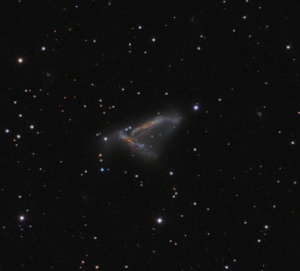
|
NGC772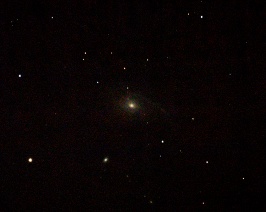
|
NGC4490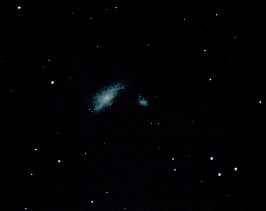
|
|
Designation: NGC7253AB Alternate Name: Arp278 Constellation: Pegasus Imaging Date: October 13, 2023 Imaging Location: Concord Exposure Time: 140 frames@180sec ~ 7.0hrs Gain Setting: 100 Imaging Device: ZWO ASI2600 Optics: Classic LX200 12" SCT Focal Reducer: Meade Series 4000 f/6.3 Filter: none Apparent Size: 1.7' x 0.5' / 1.6' x 0.5' Comment: These two spiral galaxies are thought to be colliding, as they both show active "starburst" activity - large scale, extremely high-rate star formation, presumed to be caused by the galaxy interaction. The galaxies are about 200 million light years away. Click here for a closeup view. |
Designation: NGC772 Alternate Name: Fiddlehead Galaxy Constellation: Aries Imaging Date: January 2, 2017 Imaging Location: Concord Exposure Time: 85 frames@20sec ~ 28.3min Gain Setting: ISO 1600 Imaging Device: Canon Rebel T3i Optics: LX200R 10" SCT Focal Reducer: Optec Lepus 0.62X Filter: none Apparent Size: 7.2' x 4.3' Comment: This peculiar galaxy, also known as Arp78, is about 106 million light years distant with a diameter roughtly twice that of the Milky Way. The slightly elongated elliptical object lower and to the left is its companion galaxy, NGC770, at a distance of about 160,000 light years from the NGC772 core. |
Designation: NGC4490 Alternate Name: Cocoon Galaxy Constellation: Canes Venatici Imaging Date: June 4, 2013 Imaging Location: Concord Exposure Time: 80 frames@20sec ~ 26.7min Gain Setting: ISO 3200 Imaging Device: Canon Rebel T3i Optics: LX200R 10" SCT Focal Reducer: Optec Lepus 0.62X Filter: none Apparent Size: 5.0' x 2.0' Comment: |
M77
|
NGC1961
|
NGC1421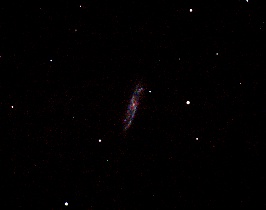
|
|
Designation: M77 Alternate Name: NGC1068 Constellation: Cetus Imaging Date: November 21, 2014 Imaging Location: Concord Exposure Time: 79 frames@20sec ~ 26.3min Gain Setting: ISO 1600 Imaging Device: Canon Rebel T3i Optics: LX200R 10" SCT Focal Reducer: Optec Lepus 0.62X Filter: none Apparent Size: 7.1' x 6.0' Comment: Closest and brightest example of a Seyfert galaxy, containing a very active black hole approximately 15 million times the mass of our Sun. |
Designation: NGC1961 Alternate Name: IC2133 Constellation: Camelopardalis Imaging Date: January 30, 2022 Imaging Location: Concord Exposure Time: 276 frames@60sec ~ 4.6hrs Gain Setting: 200 Imaging Device: ZWO ASI2600 Optics: Classic LX200 12" SCT Focal Reducer: Meade Series 4000 f/6.3 Filter: none Apparent Size: 4.6' x 3.0' Comment: This is known as the NGC1961 galaxy group consisting of a total of six galaxies. Mousing over the image displays an annotation that labels the galaxies of the group. The largest of them, NGC1961 is about 200 million light years from Earth and likely over 200,000 light years in diameter! There are competing theories about the galaxy NGC1961 shown in a closesup here. Based on mass calculations, it is either a massive disc galaxy with a huge, even more massive halo (not visible), or, it's a coincidental interloper encroaching on the group, *and* there's a massive amount of unseen matter stabalizing the cluster. |
Designation: NGC1421 Alternate Name: Spiral Galaxy Constellation: Eridanus Imaging Date: January 3, 2016 Imaging Location: Concord Exposure Time: 65 frames@20sec ~ 21.7min Gain Setting: ISO 1600 Imaging Device: Canon Rebel T3i Optics: LX200R 10" SCT Focal Reducer: Optec Lepus 0.62X Filter: none Apparent Size: 3.4' x 0.8' Comment: Mag. 11.4 interacting barred spiral galaxy about 95 million light years away. |
NGC2841
|
NGC7332,NGC7339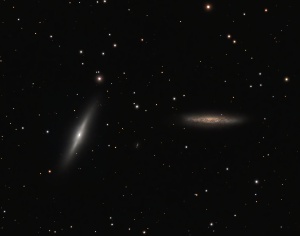
|
M33
|
|
Designation: NGC2841 Alternate Name: Tigers Eye Galaxy Constellation: Ursa Major Imaging Date: January 3, 2022 Imaging Location: Concord Exposure Time: 81 frames@180sec ~ 4.1hrs Gain Setting: 200 Imaging Device: ZWO ASI2600 Optics: Classic LX200 12" SCT Focal Reducer: Meade Series 4000 f/6.3 Filter: none Apparent Size: 8.1' x 3.5' Comment: Known as the Tiger's Eye Galaxy, this is an unbarred spiral galaxy about 46 million light years away. It is a prototype for class of galaxies called "flocculent galaxies" whose arms are patchy and discontinous. Its nucleus orbits in the opposite direction to its outer rim, suggesting some sort of interaction with another galaxy in its distant past. |
Designation: NGC7332,NGC7339 Alternate Name: Binary Galaxy Pair Constellation: Pegasus Imaging Date: September 28, 2025 Imaging Location: Concord Exposure Time: 203 frames@180sec ~ 10.1hrs Gain Setting: 100 Imaging Device: ZWO ASI2600 Optics: Classic LX200 12" SCT Focal Reducer: Meade Series 4000 f/6.3 Filter: none Apparent Size: 2.7' x 0.7' / 2.2' x 0.5' Comment: This pair of galaxies actually forms a binary system! The galaxies orbit around each other, separated visually by only about 5' . The pair is located about 45 million light years away in the constellation Pegasus, with NGC7332 on the left, and NGC7339 on the right. NGC7339 reminds me of M82, the cigar galaxy in Ursa Major, though much smaller! The actual sizes of the galaxies are also somewhat smaller than the numbers I've seen on the internet. |
Designation: M33 Alternate Name: Pinwheel Galaxy Constellation: Triangulum Imaging Date: November 18, 2020 Imaging Location: Concord Exposure Time: 98 frames@180sec ~ 4.9hrs Gain Setting: 0 Imaging Device: ZWO ASI2600 Optics: Classic LX200 12" SCT Focal Reducer: Meade Series 4000 f/6.3 Filter: none Apparent Size: 71' x 42' Comment: Also known as NGC598, this rather large distended galaxy is about 3 million light years away. This galaxy has some beautiful color to it, and you don't need an Halpha filter to get to it. This was taken using RGB only, with some restrained color saturation to boost the "natural" colors. Inevitably, you hear astroimagers combining Halpha images with RGB, but the bottom line is that *all* that information is there already - you just need a long enough exposure and a reweighting of the color to show it. Here are my two previous attempts at 7 minutes and 53 minutes exposure time with my T3i on my 10 inch. |
M74
|
M82-Supernova-2014J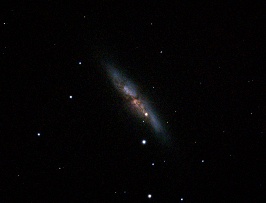
|
M104
|
|
Designation: M74 Alternate Name: Face on Spiral Galaxy Constellation: Pisces Imaging Date: December 14, 2014 Imaging Location: Concord Exposure Time: 150 frames@20sec ~ 50.0min Gain Setting: ISO 1600 Imaging Device: Canon Rebel T3i Optics: LX200R 10" SCT Focal Reducer: Optec Lepus 0.62X Filter: none Apparent Size: 10.5' x 9.5' Comment: My second attempt at this low-surface-brightness galaxy. I simply added the frames from this round to my previous set - reducing noise and improving the color somewhat. Here's my previous attempt. |
Designation: M82-Supernova-2014J Alternate Name: Cigar Galaxy Constellation: Ursa Major Imaging Date: January 29, 2014 Imaging Location: Concord Exposure Time: 150 frames@20sec ~ 50.0min Gain Setting: ISO 1600 Imaging Device: Canon Rebel T3i Optics: LX200R 10" SCT Focal Reducer: Optec Lepus 0.62X Filter: none Apparent Size: 11.2' x 4.3' Comment: !! Supernova 2014J !! Shown here near peak at approximately magnitude 10.5. Compare my image processing this time compared to my first attempt. |
Designation: M104 Alternate Name: Sombrero Galaxy Constellation: Virgo Imaging Date: May 1, 2013 Imaging Location: Concord Exposure Time: 71 frames@20sec ~ 23.7min Gain Setting: ISO 3200 Imaging Device: Canon Rebel T3i Optics: LX200R 10" SCT Focal Reducer: Optec Lepus 0.62X Filter: none Apparent Size: 8.7'x 3.5' Comment: |
M94
|
NGC6951
|
NGC6946
|
|
Designation: M94 Alternate Name: Crocs Eye Galaxy Constellation: Canes Venatici Imaging Date: June 27, 2014 Imaging Location: Concord Exposure Time: 79 frames@20sec ~ 26.3min Gain Setting: ISO 1600 Imaging Device: Canon Rebel T3i Optics: LX200R 10" SCT Focal Reducer: Optec Lepus 0.62X Filter: none Apparent Size: 11' x 9' Comment: Also known as the "Cat's Eye Galaxy" and NGC4736, this beautiful starburst galaxy is approximately 15 million light years away. It has an inner structure where intense star formation is occurring. There are also two outer rings, only one of which is visible here - looking like a ghostly halo. |
Designation: NGC6951 Alternate Name: Barred Spiral Galaxy Constellation: Cepheus Imaging Date: August 7, 2024 Imaging Location: Concord Exposure Time: 338 frames@180sec ~ 16.9hrs Gain Setting: 100 Imaging Device: ZWO ASI2600 Optics: Classic LX200 12" SCT Focal Reducer: Meade Series 4000 f/6.3 Filter: none Apparent Size: 3.9' x 3.2' Comment: This is barred spiral galaxy in Cepheus, about 75 million light years from Earth. Its nucleus is active with a supermassive black hole at its center. I was happy to see its nucleus nicely resolved! If you zoom in on the center of the galaxy, you can see a beautiful little circumnuclear ring of stars with a radius of about 5 arcseconds. The galaxy is in a field of Integrated Flux Nebulosity, shown throughout the image. I probably could have used twice as much time on this to really pull out the IFN, but I was able to get some of it here. |
Designation: NGC6946 Alternate Name: Fireworks Galaxy Constellation: Cepheus Imaging Date: September 4, 2024 Imaging Location: Concord Exposure Time: 331 frames@180sec ~ 16.5hrs Gain Setting: 100 Imaging Device: ZWO ASI2600 Optics: Classic LX200 12" SCT Focal Reducer: Meade Series 4000 f/6.3 Filter: none Apparent Size: 8.0' x 8.0' Comment: My third attempt at this beautiful galaxy...this time exposed twice as long and using my ASI2600mc, (20 times as long as the first time!) using my 12 inch Meade Classic for a total of about 16.5 hours. The colors are still spectacular, but the detail has considerably improved, as have my processing skills :) Here's my first attempt and second attempt using a DSLR at 40 minutes on my 10 inch and 422 minutes on my 12 inch respectively. |
M96
|
NGC3521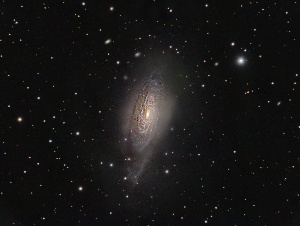
|
M106
|
|
Designation: M96 Alternate Name: NGC3368 Constellation: Leo Imaging Date: February 18, 2018 Imaging Location: Concord Exposure Time: 85 frames@20sec ~ 28.3min Gain Setting: ISO 1600 Imaging Device: Canon Rebel T3i Optics: LX200R 10" SCT Focal Reducer: Optec Lepus 0.62X Filter: none Apparent Size: 7.6' x 5.2' Comment: I was able to image some of the dark lanes in this galaxy, but it may need significantly longer exposures to get more detail. M96 is the brightest galaxy in the M96 Group in Leo, and at magnitude 10.1, is about 35 million light years away. Variations in ultraviolet emission from the core suggest the presence of a supermassive black hole. |
Designation: NGC3521 Alternate Name: Bubble Galaxy Constellation: Leo Imaging Date: May 14, 2021 Imaging Location: Concord Exposure Time: 120 frames@180sec ~ 6.0hrs Gain Setting: 100 Imaging Device: ZWO ASI2600 Optics: Classic LX200 12" SCT Focal Reducer: Meade Series 4000 f/6.3 Filter: none Apparent Size: 11.0' x 5.1' Comment: This is a spiral galaxy in Leo known for its extended halos of gas, thought to be caused by multiple mergers of it with its various satellite galaxies in the past. I like the fact that I'm able to image more background galaxies due to my much longer exposures. The detail is also decent, making visible many small pink splotches of hydrogen-alpha nebulae scattered throughout, corresponding to star forming regions in the galaxy. The galaxy has been measured to be approximately 35 million light years distant. |
Designation: M106 Alternate Name: NGC4258 Constellation: Canes Venatici Imaging Date: April 22, 2020 Imaging Location: Concord Exposure Time: 120 frames@120sec ~ 4.0hrs Gain Setting: ISO 1600 Imaging Device: Canon Rebel T3i Optics: Classic LX200 12" SCT Focal Reducer: none Filter: none Apparent Size: 18.6' x 7.2' Comment: Interesting galaxy, classified as a Seyfert galaxy and suspected of having a highly active supermassive black hole at its center. The galaxy also has a water vapour megamaser, the source of its purplish hue. This was my first serious go with PixInsight! As you can see, the results truly are astounding, I must say. Of course the 4 hour exposure with a 12 inch also helped :). There is no comparison to my previous 26 minute exposure! |
NGC2523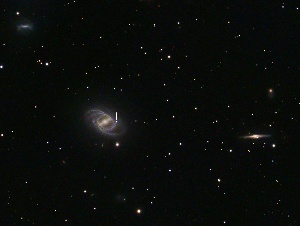
|
NGC2903
|
NGC2146
|
|
Designation: NGC2523 Alternate Name: SN 2024aeee Constellation: Camelopardalis Imaging Date: December 26, 2024 Imaging Location: Concord Exposure Time: 170 frames@180sec ~ 8.5hrs Gain Setting: 100 Imaging Device: ZWO ASI2600 Optics: Classic LX200 12" SCT Focal Reducer: Meade Series 4000 f/6.3 Filter: none Apparent Size: 2.8' x 1.8' Comment: This is a beautiful image of the barred spiral galaxy NGC2523, the largest and brightest of a group called LGG 154. It is also listed in Arp's Atlas of Peculiar Galaxies as Arp 9. A prominent inner ring encloses the 47K light year long bar. Shown at the cross-section of two white lines is the mag 16 supernova SN 2024aeee discovered Dec. 17, 2024. NGC 2523 is about 168M light years away, while NGC2523B on the right is a little further at 186M. |
Designation: NGC2903 Alternate Name: Barred Sprial Galaxy Constellation: Leo Imaging Date: March 21, 2014 Imaging Location: Concord Exposure Time: 80 frames@20sec ~ 26.7min Gain Setting: ISO 1600 Imaging Device: Canon Rebel T3i Optics: LX200R 10" SCT Focal Reducer: Optec Lepus 0.62X Filter: none Apparent Size: 12.6' x 6.0' Comment: Fascinating galaxy with rampant star formation near the core, thought to be the result of galaxy interaction with several small companion galaxies. |
Designation: NGC2146 Alternate Name: Starburst Spiral Galaxy Constellation: Camelopardalis Imaging Date: October 31, 2021 Imaging Location: Concord Exposure Time: 112 frames@180sec ~ 5.6hrs Gain Setting: 200 Imaging Device: ZWO ASI2600 Optics: Classic LX200 12" SCT Focal Reducer: Meade Series 4000 f/6.3 Filter: none Apparent Size: 6.0' x 3.4' Comment: This peculiar spiral galaxy, about 70 million light years away, is known to be experiencing violent "starburst" activity possibly resulting from a galaxy interaction with NGC2146B in its past. Here's a closeup of the main galaxy. |
M108
|
M101
|
NGC5982
|
|
Designation: M108 Alternate Name: NGC3556 Constellation: UrsaMajor Imaging Date: March 13, 2015 Imaging Location: Concord Exposure Time: 130 frames@20sec ~ 43.3min Gain Setting: ISO 6400 Imaging Device: Canon Rebel T3i Optics: LX200R 10" SCT Focal Reducer: Optec Lepus 0.62X Filter: none Apparent Size: 8.7' x 2.2' Comment: This is my second attempt at this barred spiral. I made a mistake and used ISO6400 this last time. However, I added these frames to my previous set two years ago taken at ISO3200 and voila!...Still pretty noisy, but definitely an improvement! |
Designation: M101 Alternate Name: Pinwheel Galaxy Constellation: Ursa Major Imaging Date: June 6, 2021 Imaging Location: Concord Exposure Time: 27 frames@180sec ~ 81.0min Gain Setting: 100 Imaging Device: ZWO ASI2600 Optics: Classic LX200 12" SCT Focal Reducer: Meade Series 4000 f/6.3 Filter: none Apparent Size: 29' x 27' Comment: At a distance of about 21 million light years, M101 is about 170,000 light years in diameter and contains about twice the number of stars as the Milky Way. It has a large population of H II star forming regions, many large enough to have their own NGC catalog numbers. If you mouseover the image, you can see an annotated version overlay with the labeled regions. About nine years ago, this was a milestone image for me - the first deep sky photo I took over two different nights and the first time I used a Bahtinov mask for fine tuning focus - a method I still prefer to automatic focus! Here it is for posterity :) - a 29min exposure using my 10 inch and Canon T3i. |
Designation: NGC5982 Alternate Name: Draco Galaxy Trio Constellation: Draco Imaging Date: April 10, 2022 Imaging Location: Concord Exposure Time: 156 frames@180sec ~ 7.8hrs Gain Setting: 200 Imaging Device: ZWO ASI2600 Optics: Classic LX200 12" SCT Focal Reducer: Meade Series 4000 f/6.3 Filter: none Apparent Size: 3.3' x 0.8' / 3.0' x 2.1' / 5.5' x 2.5' Comment: Left to right are NGC5981, NGC5982 and NGC5985 referred to as the Draco Galaxy Trio. I'm surprised this trio of galaxies isn't imaged more often. It's a beautiful arrangement with a multitude of other small galaxies in the background. |
NGC2336
|
M51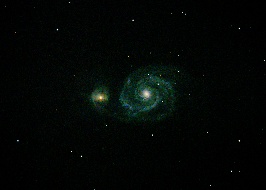
|
M31
|
|
Designation: NGC2336 Alternate Name: UGC3809 Constellation: Camelopardalis Imaging Date: December 12, 2023 Imaging Location: Concord Exposure Time: 383 frames@180sec ~ 19.1hrs Gain Setting: 100 Imaging Device: ZWO ASI2600 Optics: Classic LX200 12" SCT Focal Reducer: Meade Series 4000 f/6.3 Filter: none Apparent Size: 7.1' x 3.9' Comment: Yet another elegant and regal galaxy in Camelopardalis. The Hidden Galaxy was majestic and grand but almost ostentatious in its presentation. This galaxy is grand and majestic, but reserved and humble. The barred spiral galaxy is approximately 200,000 light-years in diameter and located approximately 100 million light years away. I ended up with a much longer exposure than I had intended (over 19h!). I don't think I really needed that long, but it means you can zoom in for some nice detail. |
Designation: M51 Alternate Name: Whirlpool Galaxy Constellation: Canes Venatici Imaging Date: March 21, 2014 Imaging Location: Concord Exposure Time: 160 frames@20sec ~ 53.3min Gain Setting: ISO 1600 Imaging Device: Canon Rebel T3i Optics: LX200R 10" SCT Focal Reducer: Optec Lepus 0.62X Filter: none Apparent Size: 11.2' x 6.9' Comment: My seventh! attempt at this beautiful double galaxy. This time I combined two nights, one using ISO1600, the other ISO3200 from the previous year. I know you're not supposed to mix ISOs but that's all I had and results weren't horrible. The color's better, focus is good, but the noise is still too high - both times I also had a Moon in the sky, so conditions weren't optimal. I need longer exposures and darker skies! |
Designation: M31 Alternate Name: Andromeda Galaxy Constellation: Andromeda Imaging Date: September 10, 2012 Imaging Location: Concord Exposure Time: 94 frames@30sec ~ 47.0min Gain Setting: ISO 1600 Imaging Device: Canon Rebel T3i Optics: 300mm Telephoto Focal Reducer: none Filter: none Apparent Size: 190' x 60' Comment: This is how Andromeda looked through the eyes of an 8 year old - just like I remembered it, taken by the 200 inch Hale telescope! |
M65-M66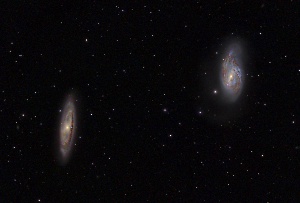
|
NGC5746,5740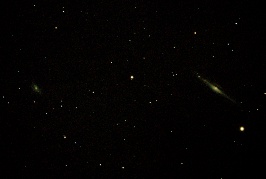
|
NGC4725,NGC4747,NGC4712
|
|
Designation: M65-M66 Alternate Name: Part of Leo Triplet Constellation: Leo Imaging Date: February 11, 2023 Imaging Location: Concord Exposure Time: 111 frames@180sec ~ 5.6hrs Gain Setting: 200 Imaging Device: ZWO ASI2600 Optics: Classic LX200 12" SCT Focal Reducer: Meade Series 4000 f/6.3 Filter: none Apparent Size: 8.7' x 2.5' / 9.1' x 4.2' Comment: Nice extended cloud detail in M66. I love the textured detail visible here - both galaxies just barely fitting in the field of view of my focal reducer. Here's my previous 28min exposure oh some many years ago with my 10inch and T3i DSLR. |
Designation: NGC5746,5740 Alternate Name: Blade and Pearl Galaxy Constellation: Virgo Imaging Date: June 1, 2014 Imaging Location: Concord Exposure Time: 80 frames@20sec ~ 26.7min Gain Setting: ISO 1600 Imaging Device: Canon Rebel T3i Optics: LX200R 10" SCT Focal Reducer: Optec Lepus 0.62X Filter: none Apparent Size: 7.4'x 1' / 2.6'x 1.3' Comment: These definitely look better together than separately! |
Designation: NGC4725,NGC4747,NGC4712 Alternate Name: NA Constellation: Coma Berenices Imaging Date: March 21, 2022 Imaging Location: Concord Exposure Time: 95 frames@180sec ~ 4.8hrs Gain Setting: 200 Imaging Device: ZWO ASI2600 Optics: Classic LX200 12" SCT Focal Reducer: Meade Series 4000 f/6.3 Filter: none Apparent Size: 9.8' x 6.8' / 3.3' x 1.3' / 1.6' x 0.8' Comment: Redshifts of NGC4725 and NGC4747 indicate both are roughly 40 million light years away but the extended plumes of NGC4747 suggest the two may have interacted sometime in the distant past. NGC4712 (lower right) is a background galaxy about 5 times further away. Regarding processing, I really needed my flats this time to get the large field of view. However, I applied a circular parametric deconvolution this time because of the full frame...there was no consistent preferential direction to the star distortion. Mouseover to identify galaxy names. |
|
Go toTop of Page |
Last Updated: Nov. 23, 2025 |
Back to Home Page. |